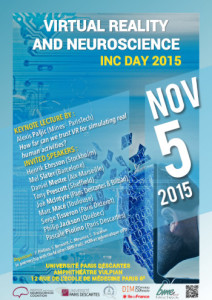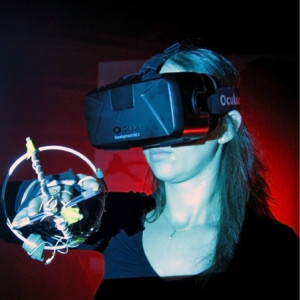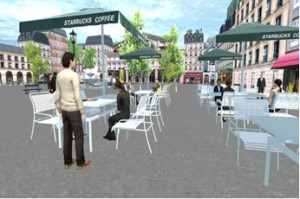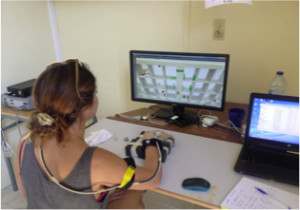 French version available on Descartes Info.
French version available on Descartes Info.
Over the years, Virtual Reality has become accessible to the greater public, especially in the gaming world. However this technology has been used in science and research labs since the 90s, and is frequently used in experiments at INC. This led us to choose Virtual Reality and Neuroscience as the theme for the 2015 edition of our science celebration.
An evening for Bachelor and first year Master 1 students will be held the night before the event.
Virtual reality is a powerful tool to study brain function and especially the neural mechanisms that underlie sensory-motricity. Virtual reality makes it possible to control and modify the sensory information that the nervous system can use to accomplish a motor task, or simply to perceive a stimulus. Virtual reality becomes even more useful when we want to study, multi-sensory integration, as does the Adaptations Sensorimotrices et Pathologies Vestibulaires team, which is trying to understand how the brain combines different types of sensory information about equilibrium and movement: vision, proprioception, touch, and vestibular signals. In that context, the virtual reality devices used include not only stereoscopic displays but also schemes capable of simulating other senses and therefore creating a multimodal virtual reality. Experimental protocols that use these devices allow to understand how the brain weighs sensory information combined from different sources, and how it minimises imperfections of individual sensory systems. Virtual reality allows to simulate gravity changes. Scientists from Laboratoire Vision, Action, Cognition and from the ‘Adaptation Sensorimotrices et Pathologies Vestibulaire team’ ask subjects to interact with moving objects in such conditions which reveals how gravity is used in our interactions with the world that surrounds us.
 New technological possibilities offered by virtual reality allow immersive environments to be created in 3D. These can be multimodal and interactive, mimicking environments and activities from daily life, in which all physiological and behavioural responses can be recorded.
New technological possibilities offered by virtual reality allow immersive environments to be created in 3D. These can be multimodal and interactive, mimicking environments and activities from daily life, in which all physiological and behavioural responses can be recorded.
The Laboratoire Mémoire et Cognition (LMC) has developed a whole range of research using virtual reality to study normal and pathological functions of human memory combined with sensorimotor activity including attention, executive functions, and emotional regulation at different stages of life. Virtual reality is particularly important to develop early evaluation tools to spot learning and memory deficiencies present in neurodevelopmental and neurodegenerative pathologies.
LMC has also established collaborations where Virtual Reality has become a powerful and interesting tool in a clinical setting. It offers new potential for cognitive remediation, using cognitive simulation with schizophrenic patients. (LMC and the ‘Physiopathologie des maladies psychiatriques’ team).
It is also promising with remediation schemes for patients who have suffered from strokes (LMC and the team Dextérité manuelle des sujets sains et des patients).
Join in on the 5th of November to celebrate Virtual Reality and its possibilities with a series of seminars from over 10 international speakers, live demos etc.… Talks are organised around three main themes: Augmented reality, Medicine and education, as well as Virtual reality and Sensory Multimodality.
Check out the program and register for free here.



